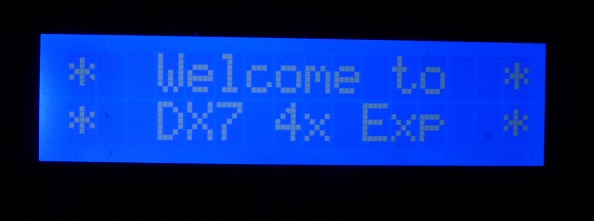The DX7 E! expansion is known for being very hard to use. The SuperMAX+ is easier, but still there are so many features that it can be hard to remember them all, … and not everyone needs them. So I’m working on yet another lost 80’s expansion, hereby dubbed “DX7 4x Expansion”.

 This expansion provides the basic elements that any DX7 owner would want, without the power, complexity or price of E! or SuperMAX. In a nutshell you get:
This expansion provides the basic elements that any DX7 owner would want, without the power, complexity or price of E! or SuperMAX. In a nutshell you get:
- 128 patches all directly accessible using standard MIDI Patch Changes.
- Velocity offset to cure the DX7 velocity shortcoming.
- A bit more MIDI flexibility and keyboard split.
And you don’t need to remember any of it since it’s all adjusted by one simple panel button. Another nice thing is that it also contains the complete latest DX7 v1.8 factory firmware, including the built-in self test. So maybe not all the bells and whistles of a doctorate level SuperMAX+ or E!, but as I said, a DX7 expansion “for the rest of us”.


Will the expansion eliminate the need for a battery memory?
Not at this time. I don’t know that it is possible to do that. There is one RAM chip soldered on the board that needs the battery.
The SuperMAX+ has space for a removable coin cell on it.
Like ALL the other expansions, this one banks out the RAM patch (voice) space. I will think about your question though in case a light bulb goes on.
The confusing example you quote in your user manual seemed
pretty straight forward when I wrote it. At the time it seemed ok
but it was written from an engineering view point. Now perhaps it
is a bit confusing. I had a fun time disassembling the yamaha rom
on a timex computer. I wrote an emulator that ran on the timex. It
took overnight to get from startup to the main loop.
Fun times
I believe it! It think this expansion could hit a sweet spot for people who use the DX7, but don’t want it to be any harder to use than it already is.
I could never get the stock unit to function reliably, even after laying my own board out for it. Power-on always seemed to trash something. I then decided to change the memory map (decoding on the ram banking, etc) and it’s now quite stable. There are a few other firmware changes I have in mind. I’ve got some of the original DX7 disassembled (properly, not just by a software package). I have thought to myself how hard it must have been to make these expansions “back in the day”.
The original boards were laid out with black tape and scissors and wired by hand. The only way I could keep the ram from being corrupted was to use 2 diodes in the chip select so the select would go low sooner and shut the ram chips down before power was gone. I think it was on power down that the ram got trashed.
Greetings;
Will this product fit in a TX7 and will it be available for sale anytime soon? It seems like a really useful upgrade.
Happy end of 2016 and Best of luck in 2017!
Hello and thank you. It will not fit in the TX7. I can’t say for sure if or when it may be available for the TX7. The DX7 one will be available again shortly after the holidays.
Hi & Tx!
Is it there installable on a DX7IIFD?
Or for the DX7II is better the SuperMAX?
Best regards,
G
There are no expansions for the DX7 II or DX7 II FD except the E!
I have another one of these retro DX7 expansions in the works. This new one is also 128 patches (voices as Yamaha calls them) and is kind of a hybrid between this 4x one here and the SuperMAX+. Anyway keep your eyes peeled.
I’m eagerly waiting on a SuperMax, will the hybrid board have the arpeggio function?
This board doesn’t feature an arpeggiator, but there are many outboard arpeggiators that you can buy that will work with all your MIDI synths.
I also have another 4x expansion that is similar to this one but also features voice/stacking and detune. I’m thinking of creating a 4x board with two expansions on it that the user can choose which expansion they prefer.
Hi,
I am also creating my own ROM for the DX7, including improving the microtuning features of the synth. I’ve also had to write my own disassembler on an MSX computer and disassemble by hand (on paper). This is going OK, but I have no idea of where any of the registers are and what they do and variables in memory and what they do etc. I would dearly love some information on this. For example the HD6303 will receive some key code information from the slave CPU and store it somewhere in memory. Maybe I will need to disassemble the slave CPU too, or just keep going and hope I can nut it out. Please email me if you do have any information or to exchange ideas etc.
Thanks,
Daniel.
I’m kind of in the same boat at this point. I don’t think you can extract the code from the slave CPU since the code is on-board, but I’m not 100% sure. Makes you wonder how the SuperMAX and Greymatter guys did it back in the day, but rumor has it that Greymatter was hooked up with Yamaha. I think the Greymatter guy is still around so you might be able to get some pointers from him. Speaking of, … the E! has some advanced tuning capabilities so that might be the path of lesser pain.